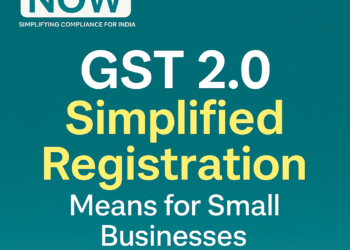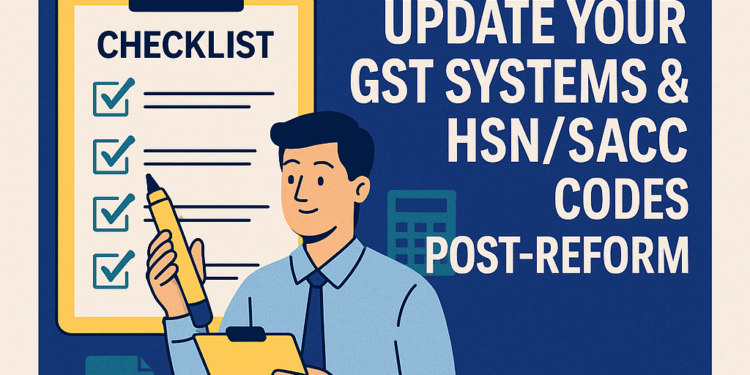🧾 Introduction: GST Reform 2025 and What It Means
The GST 2.0 reforms, effective from September 2025, have brought in major structural changes — including revised HSN (Harmonized System of Nomenclature) and SAC (Service Accounting Code) classifications.
These changes aim to simplify indirect tax compliance, standardize product and service categorization, and improve accuracy in GST return filings.
For accountants, CAs, and finance teams, this reform calls for immediate system updates to avoid mismatched filings, invoice rejections, or input tax credit (ITC) issues.
⚙️ Why Updating HSN/SAC Codes Matters
| Issue | Impact if Not Updated |
|---|---|
| Wrong HSN/SAC in invoices | GST returns may get auto-flagged for review |
| Input Tax Credit mismatch | Vendor filings won’t match buyer records |
| E-invoicing errors | Invoice rejection or delay in GSTR-1 upload |
| Legal non-compliance | Penalties up to ₹25,000 under Section 125 of the CGST Act |
| Business credibility | Vendors and clients may face reconciliation problems |
Key takeaway: Every accountant must ensure that ERP, billing, and e-invoicing systems reflect the new HSN/SAC master codes before the next return cycle.
📋 Checklist for Accountants and Finance Teams
Here’s a comprehensive 10-step checklist to ensure your GST systems are fully updated and compliant with post-reform requirements.
✅ 1. Download the Latest HSN/SAC Code List
- Visit the official CBIC GST Portal or ICEGATE.
- Download the revised master list (effective September 22, 2025).
- Cross-check codes for your business vertical — manufacturing, trading, or service-based.
✅ 2. Update ERP / Accounting Software
- Ensure your Tally, Zoho Books, QuickBooks, or SAP systems have the new code library.
- Check with your software vendor if they’ve released a GST 2.0 compatibility patch.
- For custom ERPs, coordinate with IT teams to upload the new master sheet.
✅ 3. Validate Product and Service Mapping
- Review your product master data.
- Ensure each SKU or service line item is linked to the correct HSN or SAC.
- For dual-use items (goods + services), verify classification with CBIC’s reference table.
✅ 4. Reconcile Input Tax Credits
- Cross-check vendor invoices — ensure they also reflect the new HSN/SAC structure.
- Use the GSTR-2B auto-fill tool to validate correctness.
- Flag discrepancies early to avoid ITC blockage.
✅ 5. Update E-Invoicing Templates
- Modify your invoice XML templates with the new 8-digit HSN format.
- Test uploads on the NIC sandbox before generating live invoices.
- Validate JSON schema compliance to prevent “HSN Invalid” errors.
✅ 6. Revise Purchase Order Templates
- Ensure all new POs, GRNs, and invoices generated after September 2025 carry updated codes.
- Update terms of trade with vendors to maintain consistency in billing.
✅ 7. Train Finance & Operations Teams
- Conduct short internal workshops on the changes.
- Provide quick reference sheets for top 20 frequently used codes.
- Encourage routine validation before filing returns.
✅ 8. Run a Mock GSTR-1 & GSTR-3B Filing
- Do a dry run with your September data.
- Ensure no mismatches occur between HSN/SAC and taxable value slabs.
- Fix mapping errors before the October filing cycle.
✅ 9. Maintain an Audit Log of Changes
- Keep a log of all master data updates (old code vs. new code).
- Retain digital records for audit and departmental queries.
- This helps during GST scrutiny or reconciliation audits.
✅ 10. Subscribe to Official CBIC Circular Alerts
- Stay updated via CBIC’s monthly newsletter or Twitter handle (@cbic_india).
- Watch for quarterly addendums that may revise codes further.
- Bookmark your region’s jurisdictional commissionerate for clarifications.
🧮 Example: Before and After Code Revision
| Item | Old HSN Code | New HSN Code (2025) | Tax Rate |
|---|---|---|---|
| Plastic packaging material | 3923 | 39239010 | 18% |
| IT consulting services | 998313 | 99833110 | 18% |
| Ayurvedic formulations | 30049011 | 30049090 | 12% |
| Printing services | 998912 | 99893120 | 12% |
🧠 Pro Tip for CAs and Accountants
If you manage multiple clients, create a centralized code tracker in Excel or Google Sheets with:
- Old vs. new HSN/SAC
- Client name
- Invoice format version
- Last updated date
This ensures audit readiness and helps demonstrate proactive compliance.
🏁 Conclusion: Accuracy Is the New Compliance Currency
The GST reforms of 2025 are designed to streamline indirect tax management and bring more transparency. But success depends on how quickly accountants and businesses adapt.
By following this checklist, you’ll ensure seamless transition, prevent filing errors, and maintain compliance under the new GST 2.0 regime.
In the digital era of taxation, keeping your systems updated is no longer optional—it’s strategic.

















